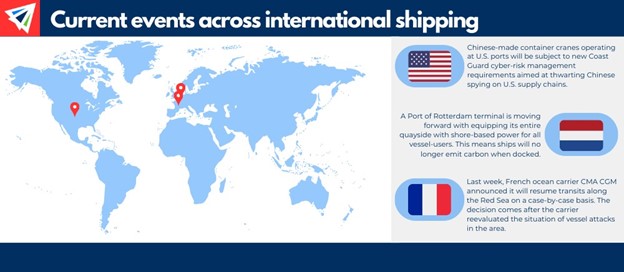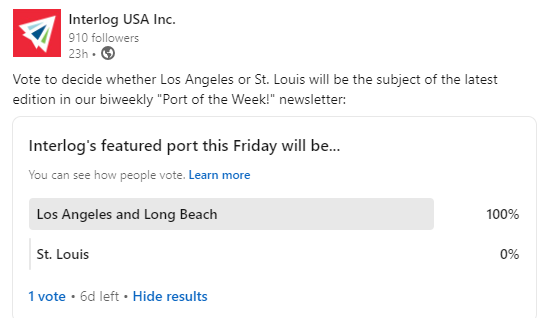Competitive Edge
March 6th, 2024
Stay Current with InterlogUSA
Latest Industry Happenings and Market Updates:

IMPORT: Asia to North America (TPEB)
Recent Developments:
- Ocean carriers did not implement general rate increases for the first half of March.
- While vessel congestion has not been a problem at East Coast ports, occasional episodes of vessel bunching have been reported the Port of New York and New Jersey. Read our archive of February’s Interlog Insights newsletter for more information!
Rates: Rates have softened into March. However, they remain disproportionately higher on containers bound for the East Coast.
Space: Space is mostly open but has tightened in pockets.
Capacity: Longer transit times around southern Africa (to avoid the Red Sea) are absorbing vessel capacity. However, carriers remain well-supplied with available vessels to manage the adjustment. There is no significant capacity crunch at this time.
TIPS:
- Hold your logistics partners accountable for frequent updates regarding current market conditions and routing impacts.
- Be flexible and adaptive to alternative service options, especially as it relates to potential savings on cost or transit.
IMPORT: Europe to North America (TAWB)
Recent Developments:
- Europe’s three largest container ports—Rotterdam, Antwerp, and Hamburg—have all reported sharp declines in volume for 2023. Their performances reflect a broader theme of economic anemia looming over Europe.
Rates: Rates are showing signs of receding in March. Low demand remains wielding influence over the market.
Space: Space is open.
Capacity: Capacity remains abundant. Carriers are partially curbing this by reducing the size of vessels operating on transatlantic lanes. Though, significant blank sailing programs have not been implemented.
Equipment: Availability on both origin and destination sides, unless advised otherwise.
TIPS:
- Book at least three weeks prior to the ready date.
- Communicate with your logistics partners to ensure that you’re up to speed on the EU ETS program and its evolving impacts on transatlantic trade.
- Keep an eye on carrier discretion when it comes to their managing of the market. While this trade favors shippers at the moment, carriers could become more aggressive with tactics, like rate increases or blank sailings, to prevent further lossmaking.
EXPORT: North America to Asia
Rates: Rates have creeped upward into March.
Capacity: Space remains open, particularly from West Coast ports, however carriers remain curbing capacity via blank sailings and slow steaming as U.S. import demand remains challenged.
Equipment: There are no significant deficits or bottlenecks, however coordinate closely with logistics partners as conditions may vary case by case.
TIPS:
- Insufficient communication with sailing schedules can lead to higher detention and demurrage fees as well as higher trucking and storage costs. Ensure your logistics partners are not keeping you and your cargo in the dark.
Freight News
CMA CGM Resumes Some Red Sea Transits
CMA CGM announced they will attempt to resume some Red Sea transits – on a case-by-case basis.
“The situation is being closely assessed for each vessel before each transit, routing choices therefore cannot be anticipated or communicated. Otherwise, all other vessels are rerouted via the Cape of Good Hope,” the carrier said in a statement.
Since mid-November, the Houthis have been attacking ships in and around the Red Sea, causing vessels to divert and go around the Cape of Good Hope instead of the Suez Canal. Over the weekend a ship sank after it was hit by a missile two weeks ago. Additionally, on Monday the U.S. military reported two incidents, per reports.
Port of Virginia Opens a Wider Channel for Ultra-Large Container Vessels
The Port of Virginia’s wider shipping channel is open for Ultra-Large Container Vessels (ULCV). This knew wider channel will allow large vessels to reduce the amount of time they spend on berth, by 15 percent – the Port said in a statement.
“Our wider channel sets the Port of Virginia apart by allowing for consistent vessel flow, increasing berth and container yard efficiencies, and further improving harbor safety,” says Stephen A. Edwards, CEO and Executive Director of the Virginia Ports Authority.
The Port is also plans to dredge it and the Norfolk Harbor to 55 feet deep and the ocean approach to 59 feet deep. Once this is complete, the Port of Virginia will have the deepest and widest channels on the U.S. East Coast.

Vote in This Week's 'Port of the Week' Poll
Every other week we post a poll on our LinkedIn page, where you can cast your vote on which port you would like to see featured in our deep dive on Friday.
Vote in this week’s port poll battle: Port of St. Louis vs. Ports of Los Angeles/Long Beach
Consider subscribing to our biweekly “Port of the Week” newsletter to continue getting a closer look at various ports (and inland ports), globally domestically.
Watch January's Webinar
TOPICS: The State of Global Trade
– Updates on the Red Sea/Suez Canal and the Panama Canal
– Rates/Capacity, routing options, and how all, or any, of this impacts you.
Sign Up For Our March Webinar
Our next webinar is Wednesday, March 20th, at 10am CST!
We will be announcing topics soon. Register Today!
(Please note: After you register, if you do not see your webinar invite to make sure you check your junk/spam email for the webinar invite. Reach out if you have any questions at support@interlogusa.com)
If you have any topic suggestions or questions for our experts..
please reach out to us at support@interlogusa.com
Interlog  Insights
Insights
Last week, we revealed our week one March Insights. We discussed how carriers that are part of The Ocean Alliance have agreed to an extension till 2032. Plus the Gemini Cooperation is set to relegate select Asian ports from main gateways to feeder ports under its envisioned network.
Our subscribers (it’s free to sign-up) are able to see our weekly insights every month in real time, when they get sent out every Friday at 10am CST.
Sign up today so you won’t miss our March week two insights, this coming Friday!
Sign up for our
industry answers
Our team works to provide valuable, unique, and relevant content to assist you in finding solutions. Sign up now.

